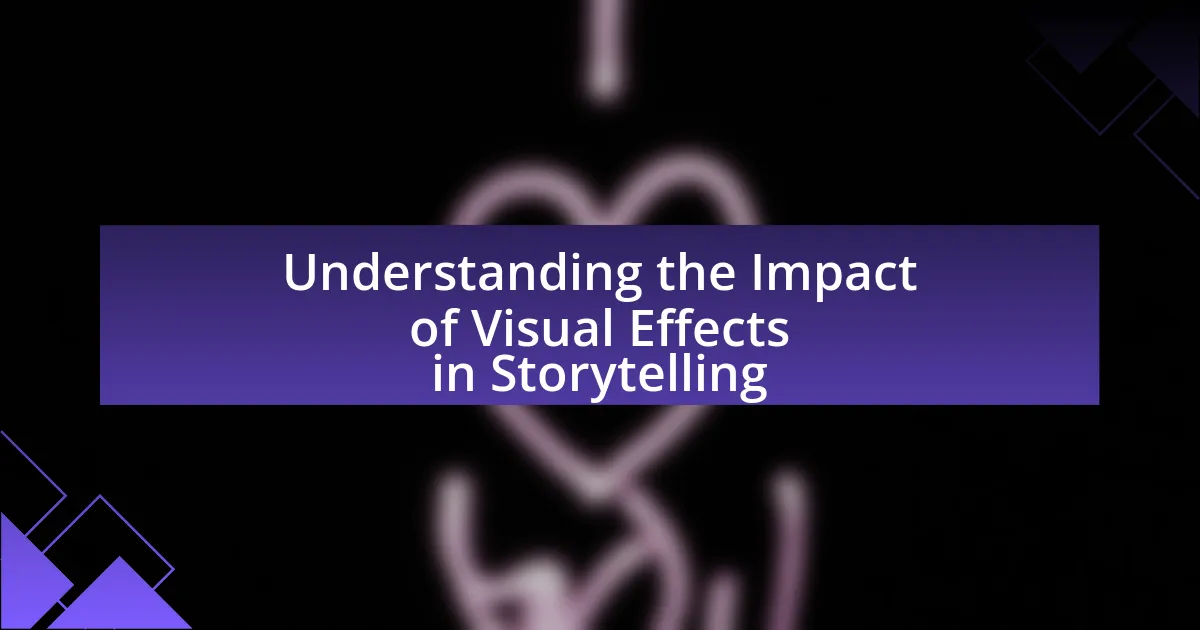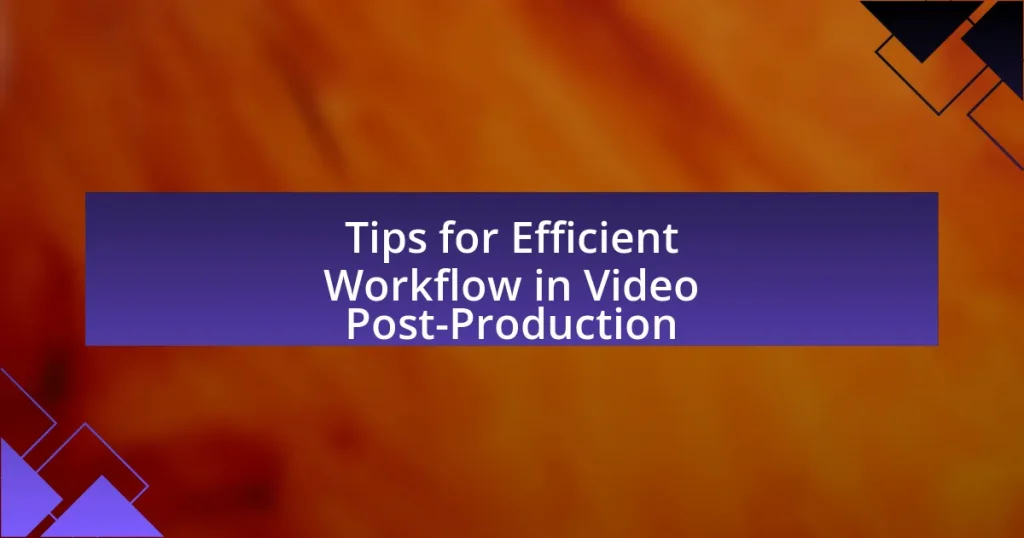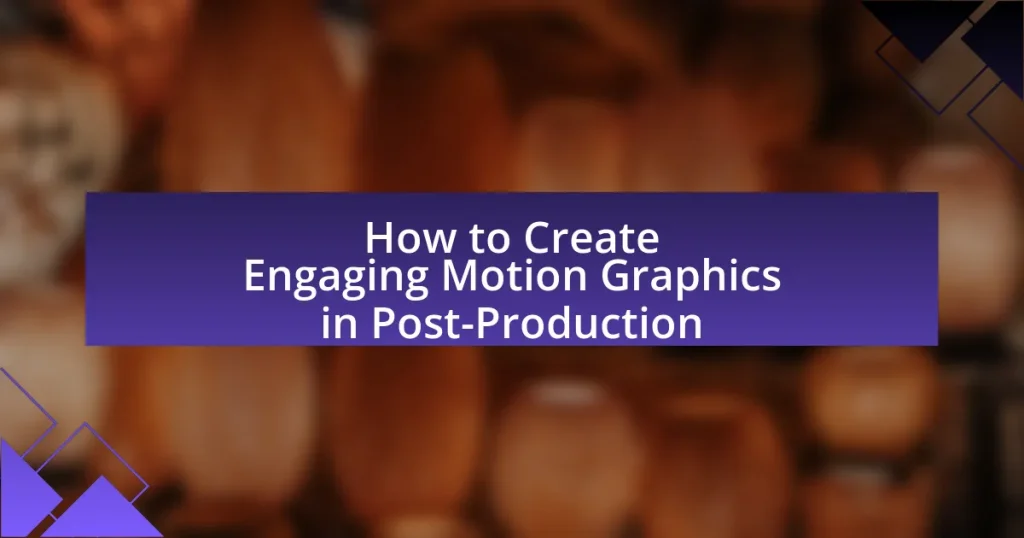Visual effects (VFX) play a crucial role in modern storytelling by enhancing narrative elements, evoking emotions, and immersing audiences in fantastical worlds. This article explores how VFX contribute to world-building, character development, and emotional engagement, highlighting their importance in films like “Avatar” and “Inception.” It also examines the various types of visual effects, the challenges filmmakers face in their integration, and best practices for ensuring that these effects serve the story effectively. Additionally, the article discusses trends in visual storytelling and the impact of audience feedback on the use of visual effects.
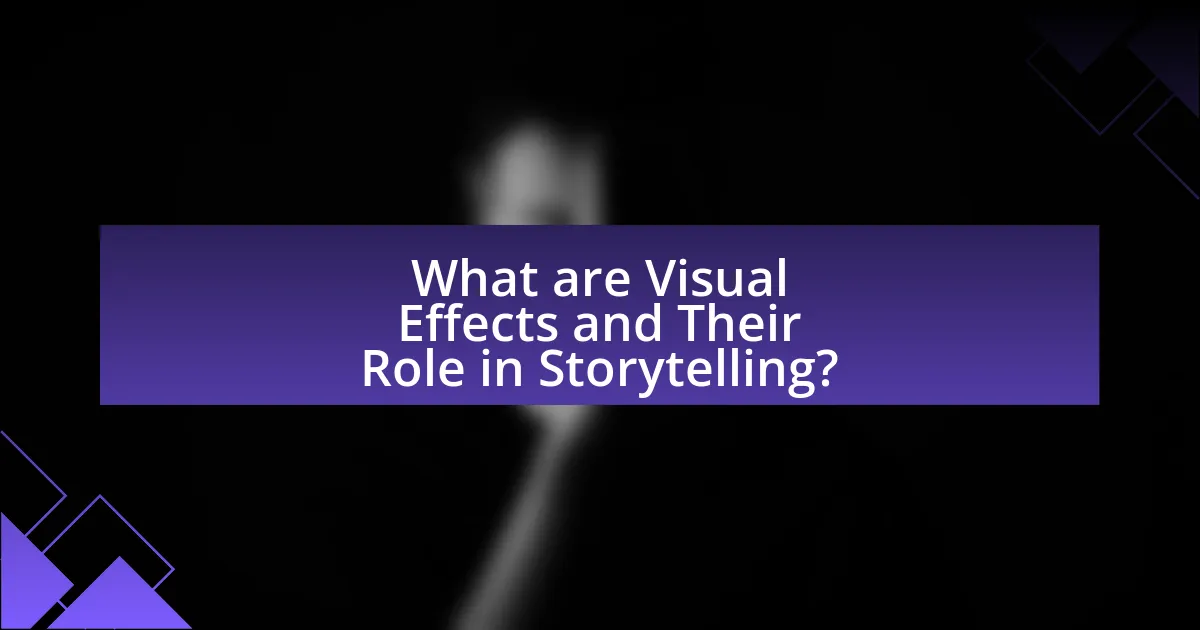
What are Visual Effects and Their Role in Storytelling?
Visual effects (VFX) are digital enhancements added to film and television to create environments, characters, and actions that would be impossible or impractical to capture on camera. Their role in storytelling is to enhance narrative elements, evoke emotions, and immerse audiences in the story world. For instance, films like “Avatar” and “The Lord of the Rings” utilize VFX to create fantastical worlds and creatures, which are integral to the plot and character development. Studies show that effective use of visual effects can significantly increase audience engagement and emotional response, as evidenced by the success of blockbuster films that rely heavily on VFX to tell their stories.
How do visual effects enhance narrative elements?
Visual effects enhance narrative elements by creating immersive environments and visual storytelling that deepen emotional engagement. For instance, films like “Avatar” utilize advanced visual effects to transport viewers to alien worlds, thereby enriching the narrative by allowing audiences to experience the story’s setting in a visceral way. This use of visual effects not only captivates the audience’s attention but also supports character development and plot progression, as seen in “Inception,” where visual effects illustrate complex concepts like dreams within dreams, making the narrative more accessible and engaging.
What specific storytelling techniques are improved by visual effects?
Visual effects enhance several specific storytelling techniques, including world-building, character development, and emotional engagement. World-building is improved as visual effects create immersive environments that transport audiences to fantastical settings, making the narrative more believable and engaging. Character development benefits from visual effects by allowing for the portrayal of superhuman abilities or transformations, which can deepen audience connection to characters. Emotional engagement is heightened through visual effects that amplify dramatic moments, such as explosions or supernatural occurrences, making the audience feel more invested in the story. These enhancements are evident in films like “Avatar,” where groundbreaking visual effects created an entirely new world, significantly impacting storytelling.
How do visual effects influence audience emotions and engagement?
Visual effects significantly influence audience emotions and engagement by enhancing the storytelling experience through immersive visuals. These effects create a more vivid and believable world, which can evoke strong emotional responses; for instance, studies show that high-quality visual effects can increase viewer empathy and connection to characters. Research published in the Journal of Media Psychology indicates that audiences exposed to compelling visual effects report higher levels of emotional arousal and engagement, demonstrating that effective visual storytelling can lead to a more impactful viewer experience.
Why are visual effects important in modern storytelling?
Visual effects are important in modern storytelling because they enhance the narrative by creating immersive experiences that engage audiences on a deeper emotional level. These effects allow filmmakers to visualize complex ideas, fantastical elements, and environments that would be impossible or impractical to achieve through traditional means. For instance, films like “Avatar” and “Inception” utilize advanced visual effects to transport viewers into entirely new worlds, thereby enriching the storytelling experience. The integration of visual effects has been shown to increase audience retention and emotional response, as evidenced by studies indicating that films with high-quality visual effects often achieve greater box office success and critical acclaim.
What trends in storytelling have emerged due to advancements in visual effects?
Advancements in visual effects have led to trends in storytelling that emphasize immersive experiences and enhanced realism. Filmmakers increasingly utilize CGI and motion capture technology to create fantastical worlds and lifelike characters, allowing for narratives that were previously impossible. For instance, the use of virtual reality in storytelling has gained traction, enabling audiences to engage with stories in a more interactive manner. Additionally, the blending of live-action and animation has become more prevalent, as seen in films like “The Lion King” (2019), which showcases how visual effects can redefine traditional storytelling methods. These trends reflect a shift towards visual-centric narratives that prioritize spectacle and audience engagement.
How do visual effects contribute to world-building in narratives?
Visual effects significantly enhance world-building in narratives by creating immersive environments that engage audiences. These effects allow filmmakers and storytellers to visualize complex worlds, such as fantastical landscapes or futuristic cities, that would be impossible or impractical to construct physically. For instance, in films like “Avatar,” advanced visual effects were used to create the lush, alien world of Pandora, which captivated viewers and deepened their emotional connection to the story. This use of visual effects not only establishes the setting but also reinforces the narrative’s themes and character arcs, making the fictional world feel tangible and believable.

What Types of Visual Effects are Commonly Used in Storytelling?
Commonly used visual effects in storytelling include CGI (computer-generated imagery), practical effects, compositing, motion capture, and animation. CGI allows for the creation of lifelike environments and characters, enhancing the visual narrative significantly; for instance, films like “Avatar” utilized CGI to create an immersive alien world. Practical effects, such as animatronics and makeup, provide tangible elements that actors can interact with, as seen in “Jurassic Park.” Compositing combines different visual elements into a single image, often used in scenes requiring complex backgrounds. Motion capture records actors’ movements to create realistic animations, exemplified by films like “The Lord of the Rings.” Animation, whether 2D or 3D, serves as a storytelling medium in itself, as demonstrated by Pixar’s films. These effects collectively enhance storytelling by creating engaging and believable worlds.
What are the main categories of visual effects?
The main categories of visual effects are practical effects, digital effects, and compositing. Practical effects involve physical elements created on set, such as animatronics or pyrotechnics, which enhance realism. Digital effects encompass computer-generated imagery (CGI) that creates or alters images in post-production, allowing for imaginative visuals that are not possible in reality. Compositing is the process of combining multiple visual elements from different sources into a single image, often used to blend live-action footage with CGI seamlessly. These categories collectively contribute to storytelling by enhancing visual narratives and engaging audiences.
How do practical effects differ from digital effects?
Practical effects differ from digital effects in that practical effects are tangible, physical effects created on set, while digital effects are generated using computer software. Practical effects, such as animatronics or makeup, provide a real-world presence that can enhance the authenticity of a scene, as seen in films like “Jurassic Park,” where animatronic dinosaurs were used alongside digital effects for a more believable experience. In contrast, digital effects allow for greater flexibility and creativity, enabling filmmakers to create complex visuals that would be difficult or impossible to achieve practically, as demonstrated in movies like “Avatar,” which relied heavily on CGI to create its immersive world.
What role do CGI and animation play in storytelling?
CGI and animation serve as essential tools in storytelling by enhancing visual narratives and enabling the depiction of imaginative worlds and characters that would be impossible to create through traditional means. These technologies allow filmmakers and animators to convey complex emotions, actions, and environments, thereby enriching the audience’s experience. For instance, films like “Avatar” and “Toy Story” utilize CGI and animation to create immersive experiences that engage viewers on multiple sensory levels, demonstrating how these techniques can elevate storytelling beyond mere dialogue and live-action limitations.
How do filmmakers choose the right visual effects for their stories?
Filmmakers choose the right visual effects for their stories by aligning the effects with the narrative’s emotional tone and thematic elements. This process involves analyzing the story’s requirements, such as the setting, character development, and key plot points, to determine which visual effects will enhance the viewer’s experience. For instance, a fantasy film may require extensive CGI to create mythical creatures, while a drama might utilize subtle effects to enhance realism. Research indicates that effective visual effects can significantly impact audience engagement and emotional response, as seen in films like “Avatar,” where groundbreaking visual technology was integral to storytelling.
What factors influence the decision-making process for visual effects?
The decision-making process for visual effects is influenced by several key factors, including budget constraints, technological capabilities, artistic vision, and audience expectations. Budget constraints dictate the extent and quality of visual effects that can be achieved, as higher-quality effects often require more financial resources. Technological capabilities, such as the availability of advanced software and hardware, also play a crucial role in determining what effects can be realistically produced. Artistic vision reflects the creative direction of the project, guiding how visual effects are integrated into the storytelling. Lastly, audience expectations shape the decision-making process, as creators aim to meet or exceed the visual standards set by previous works in the genre. These factors collectively inform the choices made during the production of visual effects, ensuring they align with the overall narrative and production goals.
How do budget constraints affect the use of visual effects?
Budget constraints significantly limit the use of visual effects in film and television production. When budgets are tight, filmmakers often prioritize essential effects or opt for less expensive alternatives, which can lead to reduced visual quality or the omission of ambitious sequences. For instance, a study by the Visual Effects Society indicates that productions with budgets under $10 million typically allocate only a fraction of their budget to visual effects, often resulting in simpler, less impactful visuals compared to higher-budget projects. This financial limitation can hinder creative storytelling, as visual effects play a crucial role in enhancing narrative elements and audience engagement.
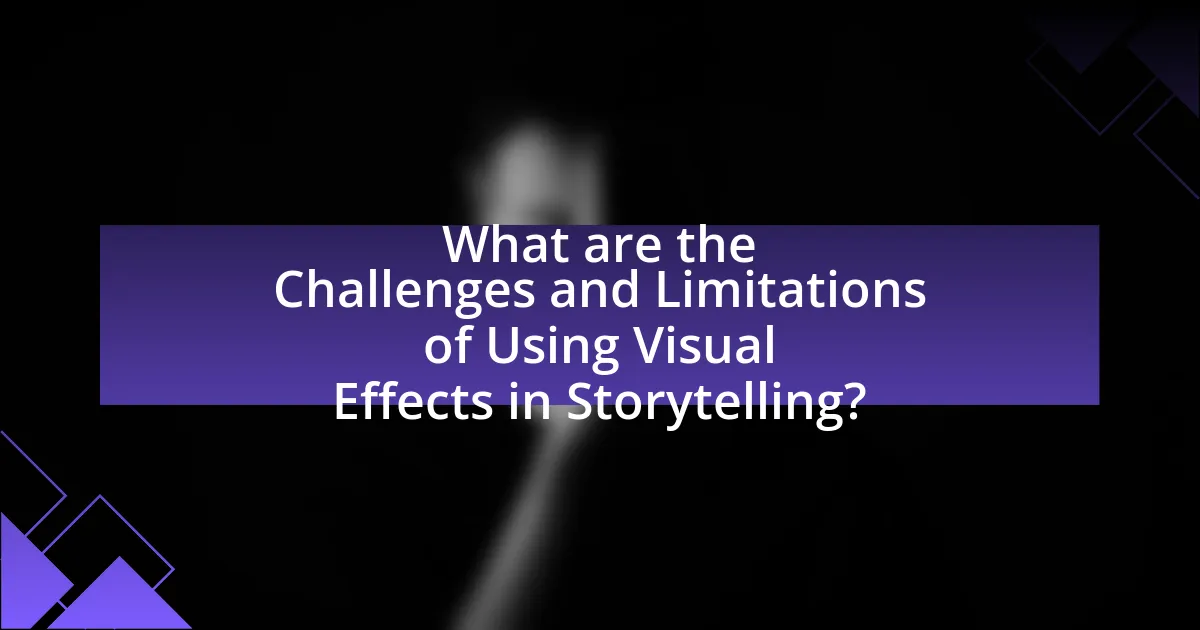
What are the Challenges and Limitations of Using Visual Effects in Storytelling?
The challenges and limitations of using visual effects in storytelling include high production costs, potential for over-reliance on technology, and the risk of distracting from narrative depth. High production costs can strain budgets, as creating high-quality visual effects often requires significant financial investment and skilled labor. Over-reliance on visual effects can lead to a diminished focus on character development and plot, as filmmakers may prioritize spectacle over substance. Additionally, visual effects can distract audiences if not integrated seamlessly, potentially undermining emotional engagement with the story. These factors collectively highlight the complexities filmmakers face when incorporating visual effects into their narratives.
What common pitfalls do creators face when integrating visual effects?
Creators commonly face pitfalls such as over-reliance on visual effects, which can detract from storytelling. This occurs when the emphasis on effects overshadows character development and plot progression, leading to a disjointed narrative. Additionally, poor integration of visual effects with live-action footage can result in a lack of realism, making scenes feel artificial and unconvincing. According to a study by the Visual Effects Society, 70% of viewers reported that poorly executed effects negatively impacted their immersion in a film. Furthermore, budget constraints often lead to rushed visual effects work, compromising quality and coherence. These factors collectively highlight the challenges creators encounter in effectively utilizing visual effects to enhance storytelling rather than hinder it.
How can over-reliance on visual effects detract from storytelling?
Over-reliance on visual effects can detract from storytelling by overshadowing character development and plot progression. When filmmakers prioritize stunning visuals over narrative substance, audiences may become disengaged from the emotional core of the story. For instance, films like “Transformers” have been criticized for prioritizing special effects at the expense of coherent storytelling, leading to a lack of character connection and investment in the plot. This imbalance can result in a viewing experience that feels hollow, as the spectacle fails to support or enhance the underlying narrative.
What technical challenges arise during the production of visual effects?
Technical challenges during the production of visual effects include rendering limitations, integration of live-action footage with CGI, and maintaining consistent visual quality across different platforms. Rendering limitations arise due to the high computational power required to create realistic effects, often leading to long processing times and potential bottlenecks in production schedules. Integration challenges occur when blending live-action elements with computer-generated imagery, necessitating precise tracking and matching of lighting and shadows to achieve a seamless look. Additionally, maintaining consistent visual quality is crucial, as variations in color grading and resolution can affect the overall storytelling experience, particularly when visual effects are viewed on diverse devices. These challenges underscore the complexity of visual effects production and the need for advanced technology and skilled professionals in the field.
How can creators effectively balance visual effects with narrative depth?
Creators can effectively balance visual effects with narrative depth by ensuring that visual elements serve to enhance the story rather than overshadow it. This can be achieved by integrating visual effects that complement character development and plot progression, thereby maintaining the audience’s emotional engagement. For instance, films like “Avatar” utilize groundbreaking visual effects to create immersive worlds while simultaneously focusing on the protagonist’s journey, demonstrating that visual innovation can coexist with strong storytelling. Research indicates that audiences respond positively when visual effects are used to support narrative themes, as seen in studies analyzing viewer engagement metrics across various genres.
What strategies can be employed to ensure visual effects serve the story?
To ensure visual effects serve the story, filmmakers should prioritize narrative coherence, character development, and thematic alignment. By integrating visual effects that enhance the plot and deepen character arcs, the audience remains engaged and the story’s emotional impact is amplified. For instance, in “Avatar,” the visual effects are intricately tied to the themes of environmentalism and connection, reinforcing the narrative rather than overshadowing it. Additionally, employing practical effects alongside CGI can create a more tangible experience, grounding the story in reality. This approach has been validated by studies showing that audiences respond more positively when visual effects complement rather than distract from the storytelling.
How can feedback from test audiences inform the use of visual effects?
Feedback from test audiences can significantly inform the use of visual effects by providing insights into audience engagement and emotional responses. When test audiences react positively or negatively to specific visual effects, filmmakers can adjust these elements to enhance storytelling. For instance, a study by the University of Southern California found that audience feedback on visual effects can lead to changes that improve narrative clarity and emotional impact, ultimately resulting in a more compelling viewing experience. This iterative process allows filmmakers to refine visual effects based on real audience perceptions, ensuring that the effects serve the story effectively.
What Best Practices Should Be Followed When Using Visual Effects in Storytelling?
Best practices for using visual effects in storytelling include ensuring that effects serve the narrative, maintaining consistency in style, and prioritizing emotional impact. Visual effects should enhance the story rather than distract from it; for example, in films like “Avatar,” effects are integrated seamlessly to support the plot and character development. Consistency in visual style is crucial, as seen in “The Matrix,” where the effects align with the film’s overall aesthetic, creating a cohesive viewing experience. Additionally, effects should evoke emotions, as demonstrated in “Inception,” where visual elements amplify tension and engagement. These practices ensure that visual effects contribute meaningfully to storytelling.
How can collaboration between departments enhance the effectiveness of visual effects?
Collaboration between departments enhances the effectiveness of visual effects by ensuring cohesive integration of artistic vision and technical execution. When departments such as art, cinematography, and visual effects work together, they can align their goals, share insights, and streamline workflows, resulting in a more unified final product. For instance, a study by the Visual Effects Society highlights that projects with interdepartmental collaboration often see a 30% increase in efficiency and a significant reduction in rework, leading to higher quality visual effects that better serve the narrative. This synergy allows for real-time feedback and adjustments, ultimately enriching the storytelling experience through more impactful visuals.
What are some tips for integrating visual effects seamlessly into a narrative?
To integrate visual effects seamlessly into a narrative, prioritize storytelling by ensuring that effects enhance rather than distract from the plot. Visual effects should serve the story’s emotional and thematic elements, creating a cohesive experience for the audience. For instance, in films like “Avatar,” visual effects are intricately tied to the world-building, enhancing the narrative rather than overshadowing it. Additionally, maintain consistency in the visual style and tone throughout the project, as seen in “The Lord of the Rings,” where effects align with the film’s overall aesthetic. Finally, collaborate closely with the director and cinematographer to ensure that visual effects are designed to complement the live-action footage, as demonstrated in “Inception,” where practical effects and CGI work in harmony to support the narrative flow.
